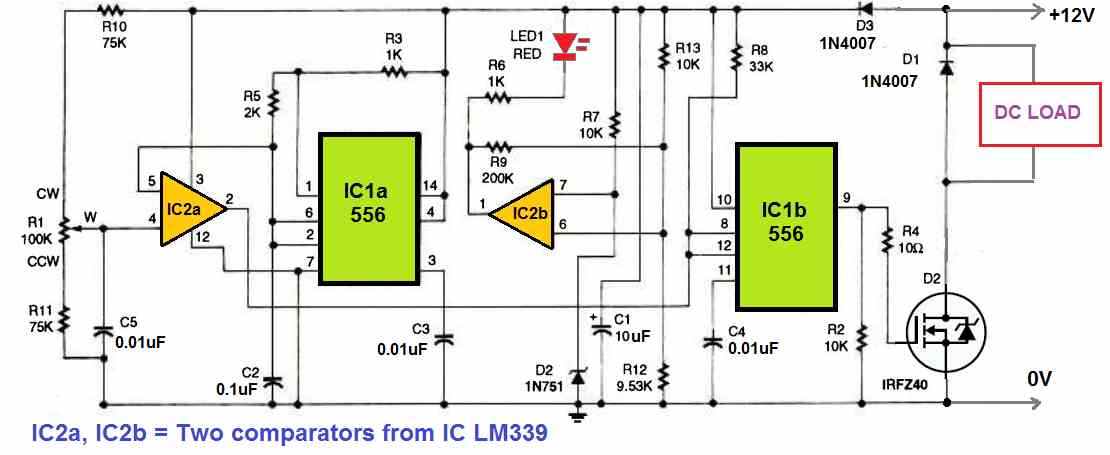In this post I have explained a DC power controller circuit which can be used for controlling the power of motors and lamps with maximum efficiency. By Sangeeta Naik
How MOSFETs conduct to Handle Power Efficiently
A minimum amount of power is lost whenever a power transistor (BJT or MOSFET) is in the turned off position.
Once they are switched on fully (100% saturated), there is another minimum loss for the device.
If they are only partially turned on, they perform the worst. Thus, the power transistor must be driven with the controller set to either completely on or completely off. This is generally implemented using PWM. This results in an average power output that corresponds to a ratio of the PWM duty cycle.


How the Circuit Works
The circuit includes a duty-cycle generator that can produce pulses with any duty cycle in between the opposites, ranging from entirely off to completely on.
Let's say, for illustration, that the load circuit that is associated to the controller uses 50% of the energy capacity.
The circuit produces electrical pulses with a 50% duty cycle, or pulses that are turned ON 50% of the time and is switched off 50% of the time. This operating mode is known as PWM (pulse width modulation).
Any DC supply source between 10 and 15 volts can power this DC power controller circuit. A voltage-to-pulse-width converter is created by combining U1a, which is 50 percent of an LM556 dual oscillator/timer and with U2a, which is one-fourth of an LM339 quad comparator, as illustrated in the above circuit diagram.
The dual oscillator/(U1a) timer's first half is set up as an astable oscillator, which produces a ramp voltage that is continually oscillating. Op-amp U2a, which makes up a quarter of the quad comparator, evaluates the voltage at its inverting input and at its non-inverting input, associated with pins 2 and 6 of U1a (pin 4).
Whenever the wiper voltage on R1 is greater than the instantaneous voltage on pins 2 and 6 of U1a, the opamp will provide a low output. The voltage at the wiper of R1 will be approximately equal to the on/off ratio of U2a's output at pin 2.
Because U2a's output cannot handle sufficient power to operate the MOSFET, it is supplied to U1b, which is utilized as a buffer for the signal. The gate of MOSFET Q1 is driven strongly on or off by the low-impedance, pulsed output of U1b at pin 9, resulting in a quick switch on / switch off time.
Additionally, the circuit incorporates a power-input detector constructed around U2b and LED1. LED1 will typically be lighted if the input power is good, but it will turn off if the input voltage falls too low.
If D1 is not included, the MOSFET could be damaged by the reverse voltage spikes produced by inductive loads during switch off periods. D1 can be removed if inductive loads (motors) are not driven by the circuit.
The recommended operating frequency for the number of motors and bulbs that may be used with this circuit would be close to 3500 Hz.
This is the frequency at which the circuit is configured.
There are a few restrictions on this type of switching. This DC power controller circuit should only be used with incandescent light bulbs and permanent-magnet DC motors.
How to Test
The output of the device should be connected to a DC lamp (any 12 volt, 0.5 to 20 watt unit will suffice), and the circuit's input should be connected to an appropriate power source (a vehicle battery would work great).
Once connected the LED should switch on. When the potentiometer is turned all the way to one extreme, the lamp should turn off; when it is turned the opposite extreme, the bulb should gradually get brighter.
That's all, the circuit now complete and in a proper working mode.

Have questions? please feel free to ask, I will try to solve it for you! The comments must be related to the above topic!